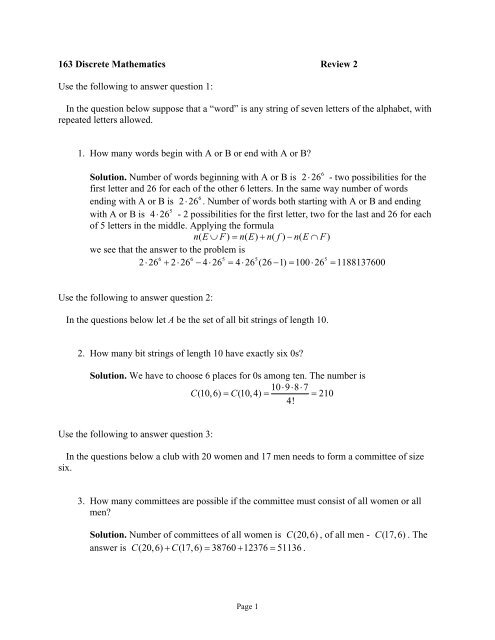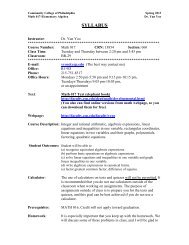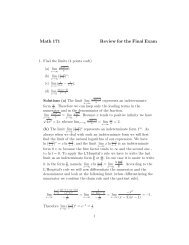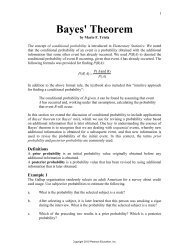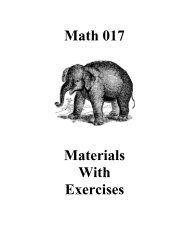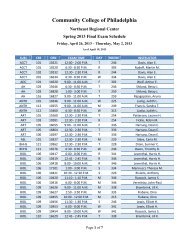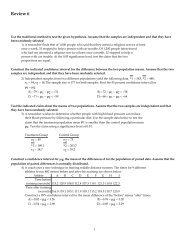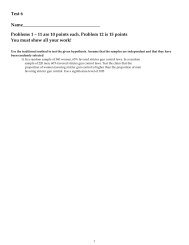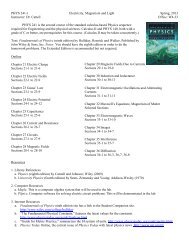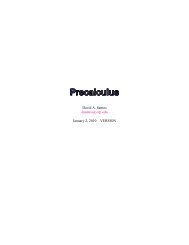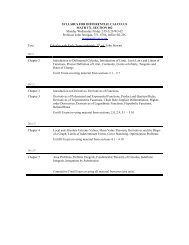163 Discrete Mathematics Review 2 Use the following to answer ...
163 Discrete Mathematics Review 2 Use the following to answer ...
163 Discrete Mathematics Review 2 Use the following to answer ...
Create successful ePaper yourself
Turn your PDF publications into a flip-book with our unique Google optimized e-Paper software.
<strong>163</strong> <strong>Discrete</strong> <strong>Ma<strong>the</strong>matics</strong> <strong>Review</strong> 2<br />
<strong>Use</strong> <strong>the</strong> <strong>following</strong> <strong>to</strong> <strong>answer</strong> question 1:<br />
In <strong>the</strong> question below suppose that a “word” is any string of seven letters of <strong>the</strong> alphabet, with<br />
repeated letters allowed.<br />
1. How many words begin with A or B or end with A or B<br />
6<br />
Solution. Number of words beginning with A or B is 226 ⋅ - two possibilities for <strong>the</strong><br />
first letter and 26 for each of <strong>the</strong> o<strong>the</strong>r 6 letters. In <strong>the</strong> same way number of words<br />
ending with A or B is 226 ⋅<br />
6 . Number of words both starting with A or B and ending<br />
with A or B is 426 ⋅<br />
5 - 2 possibilities for <strong>the</strong> first letter, two for <strong>the</strong> last and 26 for each<br />
of 5 letters in <strong>the</strong> middle. Applying <strong>the</strong> formula<br />
nE ( ∪ F) = nE ( ) + n( f) −nE ( ∩F)<br />
we see that <strong>the</strong> <strong>answer</strong> <strong>to</strong> <strong>the</strong> problem is<br />
6 6 5 5 5<br />
2⋅ 26 + 2⋅26 −4⋅ 26 = 4⋅26 (26 − 1) = 100⋅ 26 = 1188137600<br />
<strong>Use</strong> <strong>the</strong> <strong>following</strong> <strong>to</strong> <strong>answer</strong> question 2:<br />
In <strong>the</strong> questions below let A be <strong>the</strong> set of all bit strings of length 10.<br />
2. How many bit strings of length 10 have exactly six 0s<br />
Solution. We have <strong>to</strong> choose 6 places for 0s among ten. The number is<br />
10⋅9⋅8⋅7<br />
C(10,6) = C(10,4) = = 210<br />
4!<br />
<strong>Use</strong> <strong>the</strong> <strong>following</strong> <strong>to</strong> <strong>answer</strong> question 3:<br />
In <strong>the</strong> questions below a club with 20 women and 17 men needs <strong>to</strong> form a committee of size<br />
six.<br />
3. How many committees are possible if <strong>the</strong> committee must consist of all women or all<br />
men<br />
Solution. Number of committees of all women is C(20,6) , of all men - C(17,6) . The<br />
<strong>answer</strong> is C(20,6) + C(17,6) = 38760 + 12376 =51136 .<br />
Page 1
4. Find <strong>the</strong> number of subsets of S = {1,2,3,…,10} that contain exactly five elements, <strong>the</strong><br />
sum of which is even.<br />
Solution. If <strong>the</strong> sum of <strong>the</strong> elements of a subset is even <strong>the</strong>n <strong>the</strong> subset contains 0, or 2 ,<br />
or 4 odd numbers and respectively 5, or 3, or 1 even numbers. Applying <strong>the</strong><br />
multiplication principle we see that <strong>the</strong> <strong>to</strong>tal number of such subsets is<br />
C(5,0) ⋅ C(5,5) + C(5, 2) ⋅ C(5,3) + C(5, 4) ⋅ C(5,1) = 1⋅ 1+ 10⋅ 10 + 5⋅ 5 = 126.<br />
5. Find <strong>the</strong> coefficient of x 5 y 6 in <strong>the</strong> expansion of (2x − y) 11 .<br />
5<br />
Solution. The corresponding term in <strong>the</strong> expansion isC(11, 5)(2 x) ( −y)<br />
6 whence <strong>the</strong><br />
5 6<br />
5<br />
coefficient of x y is C(11,5) ⋅ 2 = 462⋅ 32 = 14784<br />
<strong>Use</strong> <strong>the</strong> <strong>following</strong> <strong>to</strong> <strong>answer</strong> question 6:<br />
In <strong>the</strong> questions below assume that you have 50 pennies and three jars, labeled A, B, and C.<br />
6. In how many ways can you put <strong>the</strong> pennies in <strong>the</strong> jars, assuming that <strong>the</strong> pennies are<br />
identical and each jar must have at least two pennies put in<strong>to</strong> it<br />
Solution. If we put two pennies in each box we will have 44 identical<br />
(indistinguishable) pennies <strong>to</strong> be distributed in<strong>to</strong> 3 labeled (distinguishable) jars. The<br />
number of ways <strong>to</strong> distribute n indistinguishable objects in<strong>to</strong> k distinguishable boxes is<br />
(see page 377 and Theorem 2 on page 373)<br />
Cn ( + k−1,<br />
k−<br />
1)<br />
In our case <strong>the</strong> number is C (46,2) = 1035.<br />
<strong>Use</strong> <strong>the</strong> <strong>following</strong> <strong>to</strong> <strong>answer</strong> question 7:<br />
In <strong>the</strong> questions below you pick a bit string from <strong>the</strong> set of all bit strings of length ten.<br />
7. What is <strong>the</strong> probability that <strong>the</strong> bit string has more 0s than 1s<br />
Solution. Let p1, p2,<br />
p3be <strong>the</strong> probabilities <strong>to</strong> have more 0s than 1s, more 1s than 0s,<br />
and <strong>the</strong> same number of 0s and 1s, respectively. Then p 1<br />
= p 2<br />
,<br />
5<br />
p3 = C(10,5)(1/ 2) (1/ 2) 5 , and p1+ p2 + p3 = 1. Therefore<br />
10<br />
1 − C(10,5)/2<br />
p1<br />
= = 0.376953125<br />
2<br />
Page 2
<strong>Use</strong> <strong>the</strong> <strong>following</strong> <strong>to</strong> <strong>answer</strong> question 8:<br />
In <strong>the</strong> questions below an experiment consists of picking at random a bit string of length five.<br />
Consider <strong>the</strong> <strong>following</strong> events:<br />
E 1 : <strong>the</strong> bit string chosen begins with 1;<br />
E 2 : <strong>the</strong> bit string chosen ends with 1;<br />
E 3 : <strong>the</strong> bit string chosen has exactly three 1s.<br />
8. Determine whe<strong>the</strong>r E 2 and E 3 are independent.<br />
Solution. Let us first find <strong>the</strong> probability of<br />
. The <strong>to</strong>tal number of bit strings of length<br />
5<br />
4<br />
5 is 2 = 32. The number of strings ending with 1 is 2 = 16. Therefore,<br />
16 1<br />
C(5,3) 5<br />
pE (<br />
2)<br />
= = . In a similar way probability of E3<br />
is PE (<br />
3)<br />
= = . Finally let<br />
5<br />
32 2<br />
2 16<br />
us compute <strong>the</strong> probability of E ∪ E . The number of strings ending with 1 and having<br />
2<br />
3<br />
6 5<br />
exactly three 1s is C (4,2) = 6 whence PE (<br />
2<br />
∪ E3)<br />
= ≠ pE (<br />
1) pE (<br />
3)<br />
=<br />
32 32<br />
are not independent.<br />
E 3<br />
E 2<br />
and E and 2<br />
9. Each of 26 cards has a different letter of <strong>the</strong> alphabet on it. You pick one card at<br />
random. A vowel is worth 3 points and a consonant is worth 0 points. Let X = <strong>the</strong> value<br />
of <strong>the</strong> card picked. Find E(X), V(X), and <strong>the</strong> standard deviation of X.<br />
5 21 1<br />
Solution. EX ( ) = 3⋅ + 0⋅ = 5 .<br />
26 26 26<br />
2 2<br />
⎛ 15 ⎞ 5 ⎛ 15 ⎞ 21<br />
V( X) = ⎜3− ⎟ ⋅ + ⎜0 − ⎟ ⋅ ≈1.40<br />
.<br />
⎝ 26 ⎠ 26 ⎝ 26 ⎠ 26<br />
σ ( X) = V( X) ≈ 1.18<br />
<strong>Use</strong> <strong>the</strong> <strong>following</strong> <strong>to</strong> <strong>answer</strong> question 10:<br />
In <strong>the</strong> questions below, describe each sequence recursively. Include initial conditions and<br />
assume that <strong>the</strong> sequences begin with a 1 .<br />
Page 3
10. 1 2 ,2 2 ,3 3 ,4 2 ,….<br />
Solution. We see that 2 , 1,2,<br />
2 2<br />
an<br />
= n n= … Therefore a − n 1<br />
a = n<br />
( n + 1) − +<br />
n = 2n<br />
+ 1<br />
and <strong>the</strong> sequence can be described recursively as<br />
a = 1, a = a + 2n+<br />
1.<br />
1 n+<br />
1<br />
n<br />
<strong>Use</strong> <strong>the</strong> <strong>following</strong> <strong>to</strong> <strong>answer</strong> question 11:<br />
In <strong>the</strong> questions below solve <strong>the</strong> recurrence relation ei<strong>the</strong>r by using <strong>the</strong> characteristic equation<br />
or by discovering a pattern formed by <strong>the</strong> terms.<br />
11. a n = −10a n − 1 − 21a n − 2 , a 0 = 2, a 1 = 1.<br />
Solution. The characteristic equation of <strong>the</strong> above recurrence relation is<br />
2<br />
r + 10r+ 21 = 0 .<br />
The left part can be fac<strong>to</strong>red as ( r+ 3)( r+ 7) whence <strong>the</strong> solutions of <strong>the</strong> characteristic<br />
equation are r1 =− 3, r2<br />
=−7<br />
, and <strong>the</strong> general solution of <strong>the</strong> recurrence relation is<br />
n<br />
n<br />
an<br />
= α1( − 3) + α2( − 7) .<br />
From <strong>the</strong> initial conditions we find<br />
α1+ α2<br />
= 2<br />
3α1+ 7α2<br />
=− 1<br />
.<br />
By multiplying <strong>the</strong> first equation by 7 and subtracting from it <strong>the</strong> second equation we<br />
get 4α 1<br />
= 15whence α = 15<br />
1<br />
4<br />
and α = 2− α = 2− 15 =− 7 . Finally<br />
2 1<br />
4 4<br />
15 n 7<br />
a<br />
n<br />
= ( −3) − ( − 7)<br />
4 4<br />
n<br />
Page 4
12. What form does a particular solution of <strong>the</strong> linear nonhomogeneous recurrence relation<br />
a n = 4a n − 1 − 4a n − 2 + F(n) have when F(n) = (n 2 + 1)2 n <br />
Solution. The associated homogeneous recurrence relation is an = 4an−<br />
1−<br />
4an−2. Its<br />
2<br />
characteristic equation r − 4r+ 4=<br />
0has solution 2 of multiplicity 2. By <strong>the</strong>orem 6 on<br />
page 469 <strong>the</strong>re is a particular solution of our nonhomogeneous recurrence relation of <strong>the</strong><br />
2 n 2 n 4 3 2<br />
form a = n 2( An + Bn+ C) = 2( An + Bn + Cn ). To find <strong>the</strong> values of <strong>the</strong><br />
n<br />
coefficients A, B, and C let us introduce <strong>the</strong> polynomial Gn ( ) = + +<br />
4 3 2<br />
An Bn Cn<br />
n n n<br />
a = 2 G( n), a = 2⋅ 2 G( n+ 1), and a = 4⋅2 G( n+<br />
2).<br />
n n+ 1 n+<br />
2<br />
. Then<br />
2<br />
Plugging in <strong>the</strong>se expressions in<strong>to</strong> <strong>the</strong> relation a = 4a − 4 a + [( n+ 2) + 1] ⋅2 n ⋅ 4<br />
n+ 2 n+<br />
1 n<br />
and dividing both parts by 4⋅ 2 n we obtain <strong>the</strong> relation<br />
2<br />
Gn ( + 2) = 2 Gn ( + 1) − Gn ( ) + n + 4n + 5.<br />
Or<br />
2<br />
Gn ( + 2) − 2 Gn ( + 1) + Gn ( ) −n −4n− 5= 0.<br />
By expanding <strong>the</strong> expressions in <strong>the</strong> left part and combining <strong>the</strong> like terms we get<br />
2<br />
( − 1+ 12 An ) + (6B+ 24A−4) n− 5 + 6B+ 2C+ 14A=<br />
0 ,<br />
1 1 11<br />
From here we find A = , B = , and C = .<br />
12 3 12<br />
Page 5
13. A market sells ten kinds of soda. You want <strong>to</strong> buy 12 bottles. How many possibilities<br />
are <strong>the</strong>re if you want at most three bottles of any kind<br />
Solution. We will use <strong>the</strong> formula on page 506 and follow <strong>the</strong> pattern of Example 1 on<br />
<strong>the</strong> same page. Our problem can be reformulated as follows.<br />
How many solutions does <strong>the</strong> equation<br />
x<br />
1+ … + x10 = 12<br />
have, where x , , 1<br />
… x1<br />
0<br />
are nonnegative integers and xi<br />
≤ 3, i = 1, …,10<br />
. Let<br />
Pi<br />
, i = 1, …,10,<br />
be <strong>the</strong> property that x<br />
i<br />
> 3. Notice that for any four distinct indices<br />
1≤ i1<br />
< i2 < i3 < i4<br />
≤10<br />
we have N( Pi P ) 0<br />
1 i 2<br />
Pi<br />
3<br />
P<br />
i 4<br />
= . Indeed, o<strong>the</strong>rwise <strong>the</strong> number of<br />
bottles would be at least 16. Therefore in our case <strong>the</strong> formula on page 506 takes <strong>the</strong><br />
form<br />
N( P … P ) = N − N( P) + N( PP) − N(<br />
PPP ).<br />
' '<br />
1 10<br />
∑ ∑ ∑<br />
i i j i<br />
1≤≤ i 10 1≤< i j≤10 1≤< i j< k≤10<br />
j<br />
k<br />
Let us now compute each term in <strong>the</strong> right part of <strong>the</strong> formula above. We can find <strong>the</strong><br />
<strong>to</strong>tal number N of nonnegative integer solutions of <strong>the</strong> equation x1+ … + x10 = 12 by<br />
<strong>following</strong> <strong>the</strong> pattern in Example 5 on page 373.<br />
N = C(10 + 12 − 1,12) = C(21,12) = C(21,9)<br />
.<br />
Next, again by <strong>following</strong> Example 5 on page 373, we see that for any index i,1≤ i≤<br />
10,<br />
whence<br />
N P C C<br />
'<br />
(<br />
i<br />
) = (10 + 8 − 1,8) = (17,8)<br />
Similarly for any<br />
and <strong>the</strong>refore,<br />
∑ N( Pi<br />
) = 10 ⋅C(17,8)<br />
.<br />
1≤≤<br />
i 10<br />
i, j,1≤ i<<br />
j ≤10we have<br />
N( PP) = C(10 + 4 − 1, 4) = C(13, 4)<br />
i<br />
∑<br />
j<br />
1≤< i j≤10<br />
N( PP) = C(10, 2) C(13, 4).<br />
i<br />
j<br />
Finally, for any i, j, k,1≤ i< j < k ≤10<br />
and<br />
NPPP (<br />
i j k)<br />
= 1<br />
Page 6
∑<br />
1≤< i j< k≤10<br />
NPPP ( ) = C(10,<br />
3).<br />
i j k<br />
The <strong>answer</strong> is<br />
C(21,9) −10 ⋅ C(17,8) + C(10,2) ⋅C(13,4) − C(10,3) = 82885 .<br />
14. How many permutations of all 26 letters of <strong>the</strong> alphabet are <strong>the</strong>re, that contain at least<br />
one of <strong>the</strong> words SWORD, PLANT, CARTS<br />
Solution. Let A, B, and C be <strong>the</strong> sets of all permutations which contain SWORD,<br />
PLANT, or CARTS, respectively. Notice that A∩ C = B∩ C =∅. Therefore by<br />
inclusion – exclusion principle for three sets we have<br />
N( A∪B∪ C) = N( A) + N( B) + N( C) −N( A∩B).<br />
Let us compute N( A)<br />
. SWORD can start from position 1 up <strong>to</strong> position 22; in each case<br />
<strong>the</strong> remaining 21 letters can be arranged in 21! ways. Therefore N( A ) = 22⋅ 21! = 22! .<br />
Similarly NB ( ) = N(<br />
C= ) 22! Next we compute N( A∩<br />
B)<br />
. Let us first look at <strong>the</strong> case<br />
when SWORD goes before PLANT. SWORD can start from any position from 1 <strong>to</strong> 17,<br />
<strong>the</strong> respective numbers of ways <strong>to</strong> place PLANT will be 17, 16,…,1. The remaining 16<br />
letters can be arranged in 16! ways. There is <strong>the</strong> same number of ways <strong>to</strong> place PLANT<br />
in front of SWORD. Thus we obtain<br />
17⋅18<br />
N( A∩ B) = 2(1 + 2 + … + 17)16! = 2 16! = 18!<br />
2<br />
The <strong>answer</strong> is<br />
N( A∪B∪ C) = 3⋅22! − 18! = 3371995780959117312000.<br />
15. Find <strong>the</strong> number of ways <strong>to</strong> climb a 12-step staircase, if you go up ei<strong>the</strong>r one or three<br />
steps at a time.<br />
Solution. Let a n<br />
be <strong>the</strong> number of ways <strong>to</strong> climb n steps by going one or three steps<br />
at a time. Then we have a recurrent relation<br />
a = a + a<br />
n n−1 n−3<br />
with <strong>the</strong> initial conditions a1 = a2 = 1, a3<br />
= 2 . From here it is easy <strong>to</strong> compute directly<br />
that a<br />
12<br />
= 60 .<br />
Page 7


